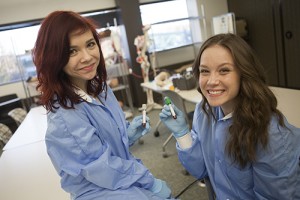Want to get into medical school?
by Tracy Kalytiak |
Being a medical doctor requires the ability to absorb, recall and immediately decide how to use a massive assembly of facts about the intricacies and tolerances of the human body. It requires discipline, to grind through calculus and biochemistry courses and earn perfect grades.

UAA students Sydney Hamilton, left, and Asia Arrant-Howell plan to attend the Alaska
PreMed Summit on March 22, at Rasmuson Hall and the Health Sciences Building.
Photo by Philip Hall/University of Alaska Anchorage
Doctors must be meticulous-comprehending the life-saving or life-ending significance of a decimal; knowing precisely how to observe and palpate skin, tissue and bone to diagnose illness or injury; easing patients through the most awkward, painful, shattering or joyful experiences they will ever experience.
The fusion of intellect and empathy appealed to Asia Arrant-Howell, 18, a UAA medical laboratory sciences major and aspiring physician who just registered for the upcoming Alaska PreMed Summit, taking place from 9 a.m.-4 p.m., Saturday, March 22, at UAA's Rasmuson Hall and Health Sciences Building.
"Being around doctors where I work, I get to see the true passion they have, the love and support they give their patients," said Asia, who works in an ophthalmology practice and has completed two UAA health sciences summer programs. "Giving care to those who need it, I enjoy participating in that. I like the collaborative effort as well as the intellectual, anatomical side. I'm fascinated with how the intricacies of medicine work together. It's a bridge where one love meets another."
Preparing the path
The Alaska WWAMI School of Medical Education at UAA hosts the Alaska PreMed Summit each year to raise awareness and give information to possible applicants and their counselors about everything that goes into becoming a competitive applicant, said Dr. Jane Shelby, Alaska WWAMI's academic director.
"There's a lot of information in one place," Shelby said of the Summit. "We've found it to be very successful in increasing the applicant pool for medical school. Overall, I would say the numbers of attendees have grown. It may have started with 75 people and now we're over 150 every year."
The University of Washington School of Medicine makes it possible for aspiring doctors in WWAMI-Wyoming, Washington, Alaska, Montana and Idaho-to receive medical education and training in their home states. Its original goals were to provide public medical education to people living in states with a population too small to afford the cost of establishing a medical school, and train physicians to practice in states that historically had a difficult time attracting an adequate number of doctors.
Twenty Alaskans are chosen each year to participate in WWAMI.
The Summit focuses on the needs of high school students, undergraduates and nontraditional students who aspire to attend medical school, offering information about what they need to do to enhance their chance of getting in, courses they need to take, job shadowing they need to participate in.
"People preparing to be an applicant need good grades, certain courses, letters of reference, job-shadowing experience, volunteer service work," Shelby said. "It's a complicated, long path."
Shelby said most WWAMI students are undergraduates and about half are nontraditional students. "Those are students coming back to school after having another career; they're deciding they want to come back, try to become physicians."
'This is something I can do'
People attending the Summit will gather first at Rasmuson Hall, to participate in mock interviews, a networking luncheon and separate breakout sessions tailored to the needs of high school students and counselors, undergraduates and nontraditional students. They will also learn details about the UW School of Medicine's admissions process and listen to advice from two keynote speakers, Dr. Melissa Shein and Dr. Nora Nagaruk, who practice family medicine at the Southcentral Foundation Anchorage Native Primary Care Center and at Norton Sound Health Corporation in Nome, respectively.
"They are both Alaska Native MDs," Shelby said. "They went through the program and have come back to practice medicine as physicians in Alaska. They're role models."
Organizers will then usher attendees through the Health Sciences Building, where they will be able to see mannequins in the simulation lab that enable medical students to diagnose and treat illnesses programmed into them electronically, glimpse WWAMI's new virtual-dissection table and learn something that's old-school: wielding a needle and thread.
"The activities are kind of like a cupcake," said Cassandra Dale, who organized the Alaska PreMed Summit. "They can see the wonderful anatomy table, which allows students to pull up images, manipulate images, pull off and add layers. And, we're offering suturing opportunities using bananas-students usually use pig feet, but bananas are less messy for the participants. The suturing is just a little skill they can take away, so they can say, 'This is something I can do.'"
Written by Tracy Kalytiak, UAA Office of University Advancement
 "Want to get into medical school?" is licensed under a Creative Commons Attribution-NonCommercial 4.0 International License.
"Want to get into medical school?" is licensed under a Creative Commons Attribution-NonCommercial 4.0 International License.














